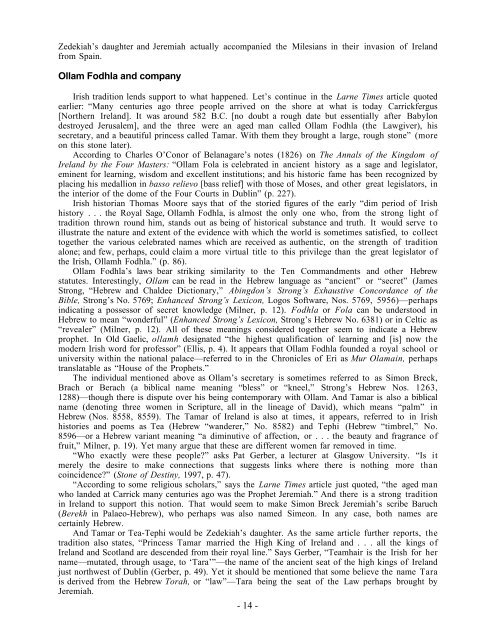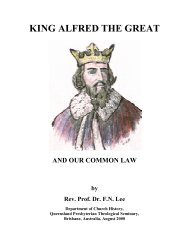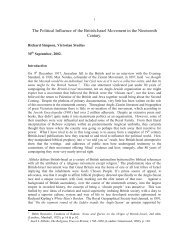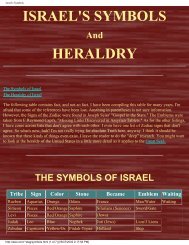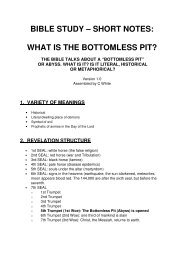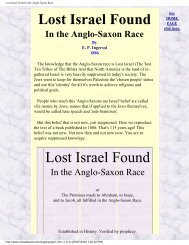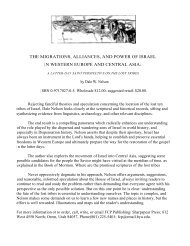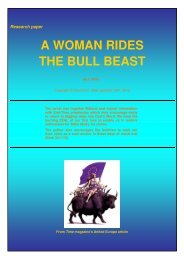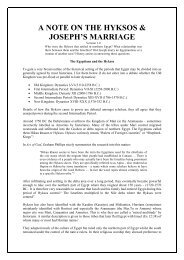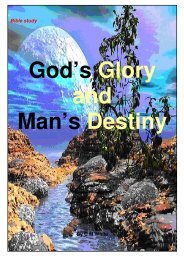The Throne of Britain: Its Biblical Origin and Future - Origin of Nations
The Throne of Britain: Its Biblical Origin and Future - Origin of Nations
The Throne of Britain: Its Biblical Origin and Future - Origin of Nations
You also want an ePaper? Increase the reach of your titles
YUMPU automatically turns print PDFs into web optimized ePapers that Google loves.
Zedekiah’s daughter <strong>and</strong> Jeremiah actually accompanied the Milesians in their invasion <strong>of</strong> Irel<strong>and</strong><br />
from Spain.<br />
Ollam Fodhla <strong>and</strong> company<br />
Irish tradition lends support to what happened. Let’s continue in the Larne Times article quoted<br />
earlier: “Many centuries ago three people arrived on the shore at what is today Carrickfergus<br />
[Northern Irel<strong>and</strong>]. It was around 582 B.C. [no doubt a rough date but essentially after Babylon<br />
destroyed Jerusalem], <strong>and</strong> the three were an aged man called Ollam Fodhla (the Lawgiver), his<br />
secretary, <strong>and</strong> a beautiful princess called Tamar. With them they brought a large, rough stone” (more<br />
on this stone later).<br />
According to Charles O’Conor <strong>of</strong> Belanagare’s notes (1826) on <strong>The</strong> Annals <strong>of</strong> the Kingdom <strong>of</strong><br />
Irel<strong>and</strong> by the Four Masters: “Ollam Fola is celebrated in ancient history as a sage <strong>and</strong> legislator,<br />
eminent for learning, wisdom <strong>and</strong> excellent institutions; <strong>and</strong> his historic fame has been recognized by<br />
placing his medallion in basso relievo [bass relief] with those <strong>of</strong> Moses, <strong>and</strong> other great legislators, in<br />
the interior <strong>of</strong> the dome <strong>of</strong> the Four Courts in Dublin” (p. 227).<br />
Irish historian Thomas Moore says that <strong>of</strong> the storied figures <strong>of</strong> the early “dim period <strong>of</strong> Irish<br />
history . . . the Royal Sage, Ollamh Fodhla, is almost the only one who, from the strong light <strong>of</strong><br />
tradition thrown round him, st<strong>and</strong>s out as being <strong>of</strong> historical substance <strong>and</strong> truth. It would serve to<br />
illustrate the nature <strong>and</strong> extent <strong>of</strong> the evidence with which the world is sometimes satisfied, to collect<br />
together the various celebrated names which are received as authentic, on the strength <strong>of</strong> tradition<br />
alone; <strong>and</strong> few, perhaps, could claim a more virtual title to this privilege than the great legislator <strong>of</strong><br />
the Irish, Ollamh Fodhla.” (p. 86).<br />
Ollam Fodhla’s laws bear striking similarity to the Ten Comm<strong>and</strong>ments <strong>and</strong> other Hebrew<br />
statutes. Interestingly, Ollam can be read in the Hebrew language as “ancient” or “secret” (James<br />
Strong, “Hebrew <strong>and</strong> Chaldee Dictionary,” Abingdon’s Strong’s Exhaustive Concordance <strong>of</strong> the<br />
Bible, Strong’s No. 5769; Enhanced Strong’s Lexicon, Logos S<strong>of</strong>tware, Nos. 5769, 5956)—perhaps<br />
indicating a possessor <strong>of</strong> secret knowledge (Milner, p. 12). Fodhla or Fola can be understood in<br />
Hebrew to mean “wonderful” (Enhanced Strong’s Lexicon, Strong’s Hebrew No. 6381) or in Celtic as<br />
“revealer” (Milner, p. 12). All <strong>of</strong> these meanings considered together seem to indicate a Hebrew<br />
prophet. In Old Gaelic, ollamh designated “the highest qualification <strong>of</strong> learning <strong>and</strong> [is] now the<br />
modern Irish word for pr<strong>of</strong>essor” (Ellis, p. 4). It appears that Ollam Fodhla founded a royal school or<br />
university within the national palace—referred to in the Chronicles <strong>of</strong> Eri as Mur Olamain, perhaps<br />
translatable as “House <strong>of</strong> the Prophets.”<br />
<strong>The</strong> individual mentioned above as Ollam’s secretary is sometimes referred to as Simon Breck,<br />
Brach or Berach (a biblical name meaning “bless” or “kneel,” Strong’s Hebrew Nos. 1263,<br />
1288)—though there is dispute over his being contemporary with Ollam. And Tamar is also a biblical<br />
name (denoting three women in Scripture, all in the lineage <strong>of</strong> David), which means “palm” in<br />
Hebrew (Nos. 8558, 8559). <strong>The</strong> Tamar <strong>of</strong> Irel<strong>and</strong> is also at times, it appears, referred to in Irish<br />
histories <strong>and</strong> poems as Tea (Hebrew “w<strong>and</strong>erer,” No. 8582) <strong>and</strong> Tephi (Hebrew “timbrel,” No.<br />
8596—or a Hebrew variant meaning “a diminutive <strong>of</strong> affection, or . . . the beauty <strong>and</strong> fragrance <strong>of</strong><br />
fruit,” Milner, p. 19). Yet many argue that these are different women far removed in time.<br />
“Who exactly were these people” asks Pat Gerber, a lecturer at Glasgow University. “Is it<br />
merely the desire to make connections that suggests links where there is nothing more than<br />
coincidence” (Stone <strong>of</strong> Destiny, 1997, p. 47).<br />
“According to some religious scholars,” says the Larne Times article just quoted, “the aged man<br />
who l<strong>and</strong>ed at Carrick many centuries ago was the Prophet Jeremiah.” And there is a strong tradition<br />
in Irel<strong>and</strong> to support this notion. That would seem to make Simon Breck Jeremiah’s scribe Baruch<br />
(Berekh in Palaeo-Hebrew), who perhaps was also named Simeon. In any case, both names are<br />
certainly Hebrew.<br />
And Tamar or Tea-Tephi would be Zedekiah’s daughter. As the same article further reports, the<br />
tradition also states, “Princess Tamar married the High King <strong>of</strong> Irel<strong>and</strong> <strong>and</strong> . . . all the kings <strong>of</strong><br />
Irel<strong>and</strong> <strong>and</strong> Scotl<strong>and</strong> are descended from their royal line.” Says Gerber, “Teamhair is the Irish for her<br />
name—mutated, through usage, to ‘Tara’”—the name <strong>of</strong> the ancient seat <strong>of</strong> the high kings <strong>of</strong> Irel<strong>and</strong><br />
just northwest <strong>of</strong> Dublin (Gerber, p. 49). Yet it should be mentioned that some believe the name Tara<br />
is derived from the Hebrew Torah, or “law”—Tara being the seat <strong>of</strong> the Law perhaps brought by<br />
Jeremiah.<br />
- 14 -


